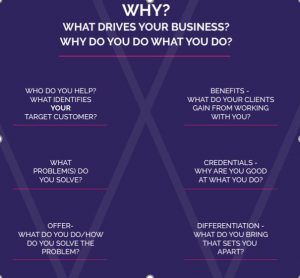
All good businesses deliver value. Yet it can be hard to communicate that value, and explain it in meaningful terms. Many businesses therefore simply talk about the ‘what’ of their business – their products, their services, their pricing.
Communicating your value means moving from the ‘what’ to the ‘so what’. It’s about finding the passion in what you do, understanding your clients and the benefits you bring to their life or business. It’s about articulating who you help, how you help them and why you help them.
Easier said than done?
It certainly can be difficult to step outside the detail of your business and to see yourself from the outside, the way your customers see you. Knowing a business from the inside out makes it hard to see from the outside in. But by using the seven-point plan below, you can be sure your message truly communicates the value you offer.
1. Why
Customers want to engage – and they feel more connected if they understand what drives you, the reasons why you do what you do. Sharing of your story, the ‘why’ behind your business, helps to build that sense of connection. I found this when I shared my own ‘Find my why’ story, which is still the one that more people connect with than any other. The desire to connect is especially true of the outward-looking, change-focussed millennial generation, who describe themselves as ‘purpose driven’.
2. Who
One of the first things your customer needs to see/hear in your message is themselves. How else do they know that you are going to be able to help them? So it is essential to be really clear about just who is your target market, to make sure your message speaks directly to them. We’re all programmed to hear messages designed for us (it’s called the ‘Cocktail Party Effect’) and yet when describing our customers, it’s all too easy to fall into the ‘I help everyone’ trap.
3. Customer context
Once you’re clear on who your target audience is, you can talk to them in their terms. This means understanding what their goals and aspirations are, and what stops them achieving those goals. I’ve been on many a sales course where they advocate starting with the customer’s ‘issues’, but it’s just as important to recognise their strengths and their goals. No-one wants to listen to a message that starts ‘Now let me tell you about your problem…’
4. Offer
This is where you finally get to talk about your product – yay! Two really important things here: firstly, the way you describe your product has to link back to the customer context. There’s no point in putting in a lot of detail that has no relevance to their goals. Secondly, think of your ‘product’ in the broadest terms – this might include, say, payment terms, delivery times, specialist expertise. Just keep testing its relevance to your target client.

5. Credentials
What makes you good at what you do? Why should your audience believe you? Credentials are you/your team’s experience, qualifications, testimonials. For your product or service, it may be shown through case studies, certifications, recognition by industry bodies. Credentials are the part of the message that gives your customers confidence that your business can do what it says it will do.
6. Differentiators
Closely aligned to credentials are differentiators. Of all the things that make you good at what you do, which ones are unique? The chances of you being the only one in your market with your offer are very slim, so you have to find the part (or combination of parts) of your offer that makes you stand out from the crowd.
7. Benefits
This is the money shot when it comes to a value message. All six of the previous points come together in the benefit to the customer. What are they going to get from choosing you? Benefits usually come in the form of lower cost, lower risk, higher revenue or higher customer engagement. Think of it as finishing the sentence ‘so the customer can…’ What can they do differently, how will their life or business change by working with you?
By using these seven points and clearly articulating your message in these terms, you’ll be certain that it resonates with your audience. You’ll have a message that is consistent in all forms, crystal clear and completely focussed on the most important person – the customer.
